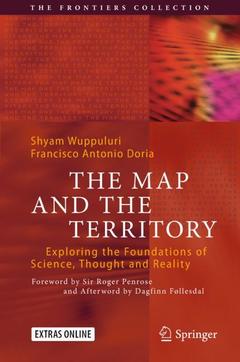The Map and the Territory, 1st ed. 2018 Exploring the Foundations of Science, Thought and Reality The Frontiers Collection Series
Coordonnateurs : Wuppuluri Shyam, Doria Francisco Antonio

List of authors who have accepted: (* = tentative)
· Ian Stewart, University of Warwick, England.
· William G Unruh, University of British Columbia, Canada.
· Gregory Chaitin, IBM and his wife Virginia Chaitin.
· Simon Saunders (*), Oxford University, Oxford.
· Simon Kochen(*), Princeton University.
· Marcelo Gleiser, Professor of physics at Dartmouth.· José Acacio de Barros, Associate professor at San Francisco State.
· Tian Yu Cao, Boston University.
· David Wolpert, Santa Fe Institute.
· Vlatko Vedral, University of Oxford.· Edward Slowik, Winona State University, USA. <
· Steven Weinstein, University of Waterloo.
· Eors Szathmary, Munich and Eötvös University.
· Barry Dainton, University of Liverpool.· John Searle (*), University of California.
Shyam Wuppuluri is an independent researcher working in the domain of foundations of science. His research interests range from philosophy to theoretical physics, mathematics and cognitive science. He is the recipient of Honra ao Mérito from the Brazilian Academy of Philosophy (Academia Brasileira de Filosofia) and has been a corresponding member of the academy since 2018. He is also the recipient of the prestigious Albert Einstein Fellowship 2020 from the Einstein Forum at Potsdam & Caputh and is a fellow of Royal Society of Arts. He is the instigating editor of several highly interdisciplinary volumes that disseminate and discuss issues underlying the foundations of sciences, and for which he has gathered the world's leading scientists and intellectuals as contributors; among them Noam Chomsky, Sir Roger Penrose, Sir Martin Rees, Daniel Dennett, A. C. Grayling, Nicholas Humphrey, Gregory Chaitin, Gerard 't Hooft, Ian Stewart, Barry Mazur, Stephen Wolfram, Paul Davies, Tyler Burge, Doron Swade, Julian Barbour, Newton Da Costa, Francisco Antonio Doria, Reuben Hersh, Nicholas Maxwell and many others.
With a foreword by Sir Roger Penrose and an afterword by Dagfinn Follesdal
Asks deep questions and provides many stimulating answers
Provides complimentary viewpoints of an eminent cast of authors from different disciplines
Appeals to all academics and laypersons with an interest in philosophical foundations
Includes commentary on classic works in the field
Includes supplementary material: sn.pub/extras
Date de parution : 02-2018
Ouvrage de 641 p.
15.5x23.5 cm
Disponible chez l'éditeur (délai d'approvisionnement : 15 jours).
Prix indicatif 137,14 €
Ajouter au panier